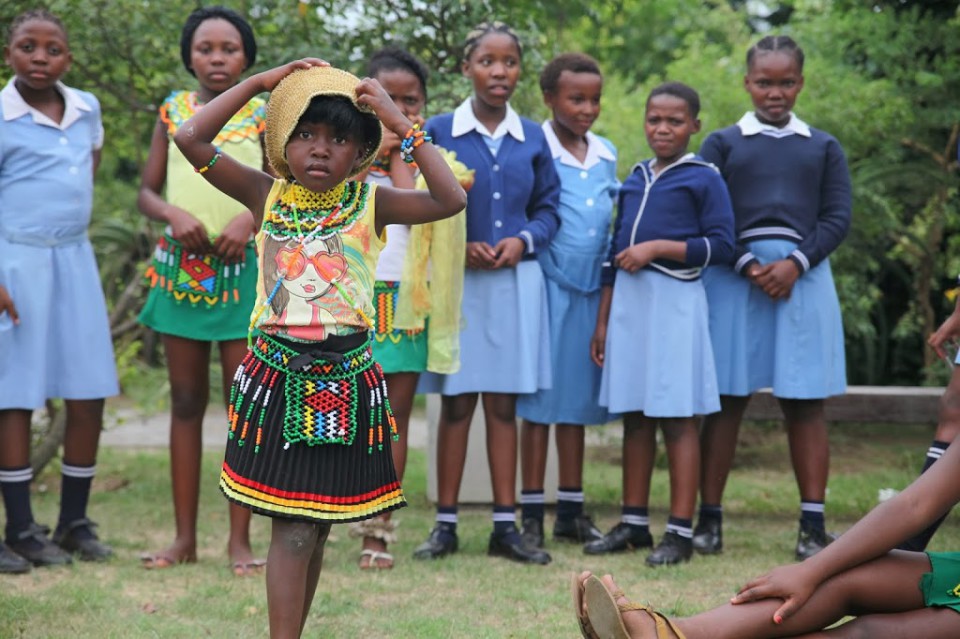“I don’t remember the time of the civil war”, Angel says. “I was only five years old.” Looking to the ground she continues “There were too many who killed each other.”
– Have you seen it?
– “Not really. Sometimes. Many times.”
– Was your family fine?
– “Yes, but… my mother died at that time. They killed her. I saw it”.
The 17-year-old is sitting under a lush, green tree, her hair wrapped up with a pink ribbon, a collier of rainbow-coloured pearls around her neck. Her words come slowly. She hardly ever speaks about her past. Angel has come to meet Peace Boat participants at the Gandhi Development Trust (GDT) in the Phoenix Settlement near Durban with her friends of a local high school and the Kasturba Primary School. “We try to forgive” she tells them. “Bhambayi is a good community now, with good people”. The place where she witnessed her mother’s murder is only a few blocks away.
It is almost a miracle. Since the riots, which started in 1992, shook the community for almost a decade and are still referred to as “civil war”, many traumatized children of Bhambayi turned to violence in search of revenge. Others took their own lives. Angel and her friends have, in contrast, become soft-spoken teenagers, still shy and vulnerable, but optimistic about their future. Among the many who have contributed to their development, two stand out – a man from India and a woman from South Africa. First there is the legacy of Mahatma Gandhi. The GDT spreads Gandhi’s message of non-violence to school children through books, workshops and collaborations with teachers, who implement his ideas in their morning speeches. Gandhi’s own great-grandaughter Ashish Ramgobin works with the organisation. She summarized his message for settlements like Bhambayi “You may well fight for your rights – but don’t use violence”.
It is here, in the Phoenix Settlement next to Bhambayi, that Mohandas K. Gandhi turned from a shy undecided lawyer into a powerful political leader. Shortly after his arrival in 1893, the young man was kicked out of the first class compartment of a train, although he had a valid ticket. His only error was that he wasn’t white. Experiencing discrimination himself made Gandhi question the rule of the British Empire in South Africa as well as in his native India. When the humiliating Asiatic Law Amendment Ordinance came into law, forcing South African Indians to register, Gandhi called on all South African Indians to resist it, non-violently. His idea of “Satyagraha” (non-violent resistance) was born, which has lived on in social movements ever since; during India’s independence struggle, the protests against the Vietnam war, the fall of the Berlin Wall and the Orange Revolution in Ukraine among many others. To set a sign against apartheid, Gandhi founded the Phoenix settlement as a model for a non-segregated neighbourhood, where so-called Coloured, Blacks and White could live and farm together. Phoenix became a symbolic place in the struggle against apartheid. In September 1983, the First National executive Meeting of the United Democratic Front was held here. Phoenix Settlement was a member of the UDF which united organizations against apartheid. The first call to free Nelson Mandela was made here and Mandela cast his first vote in 1994 not far from the Phoenix Settlement at Ohlange High School in Inanda in KwaZulu-Natal.
Despite being a beacon of tolerance and non-violence through the Mahatma’s teachings, the Settlement has also suffered violence at the end of the last century. In 1985, it was almost destroyed during the so called ‘Inanda Riots’ and overtaken by about 8000 informal settlers. It was then that it became known as Bambayi. The area was rebuilt again in 2000. It is the violence of 1992 when the area of Bambayi was the site of conflict between the African National Congress (ANC) and the Inthaka Freedom Party (IFP) each fighting for political leadership after apartheid, that the children remember. “You could already get killed, if your neighbour suspected you to vote for the wrong party” remembers Alicia Mbuyisa, the traditional healer (isangoma) of the Bhambayi community. She used her influence and political neutrality to protect all those, who ran to her house in search for shelter. When Angel lost her parents, she raised her and ten other orphans. “We call her grandmother”, Angel says, her voice full of affection. “She saved our lives”. But there were many more orphans, who, without parents, lived in great poverty and were especially vulnerable. “When I first met these children, most had an inner anger that you can’t control” Mbuyisa recalls. “They wanted to take revenge for their parents’ death”.
Her house soon became too small to adopt all of them, but she started teaching them. With Mbuyisa’s dancing group Ubuhle Bezinkanyezi, Angel performs a powerful Zulu dance for the Peace Boat participants. Their chants represent the wild animals of the steppe and their feet raise clouds of dust from the ground. Their jewellery is made of inexpensive plastic pearls, but they have crafted it themselves using traditional techniques and wear it with dignity. Today Mbuyisa teaches 90 children, 62 girls and 28 boys, in Zulu traditions and life skills such as preventing HIV/ Aids. “I make them understand, that God and a good education come first, before they can have any relationships” Mbuyisa says. In Angel’s case she seems to be successful. “I like school, really” the 17-year-old says, “Maths especially. I want to become a technical accountant or a national economist”. Angel looks up for the first time, smiling. “Yeah, I am a strong woman now!”
More photos, from a completely different perspective – that of a six year old girl from Bhambayi >>
